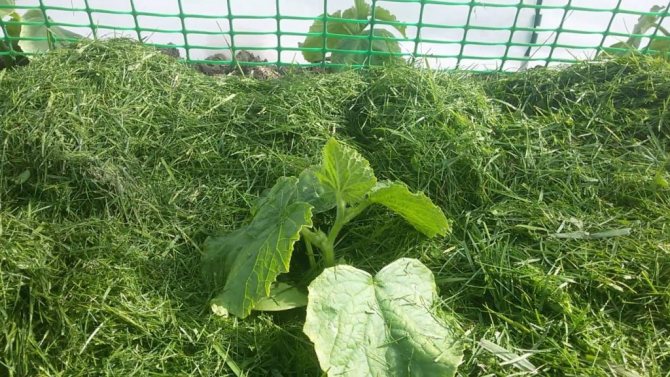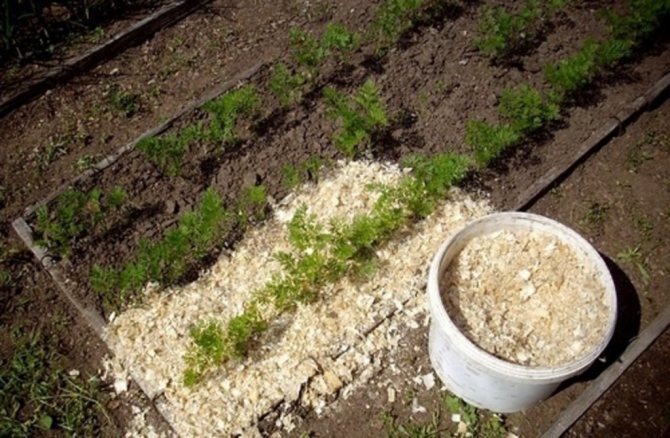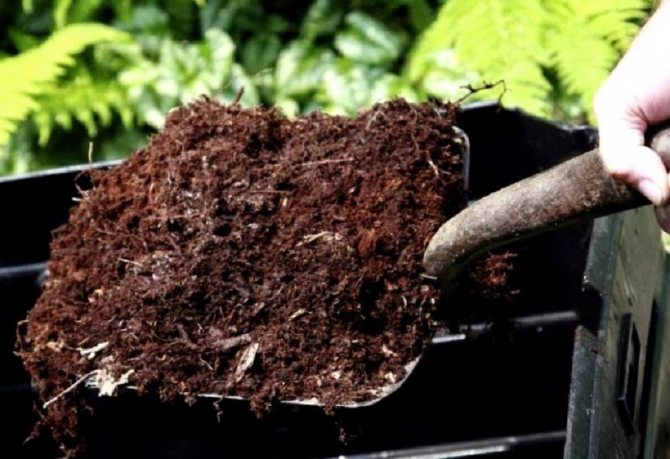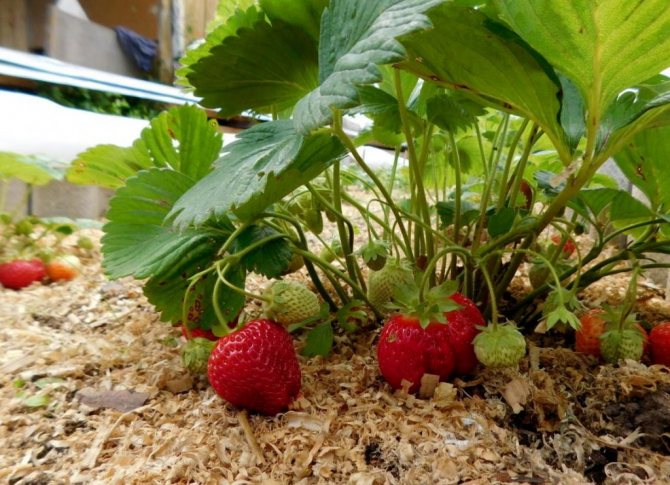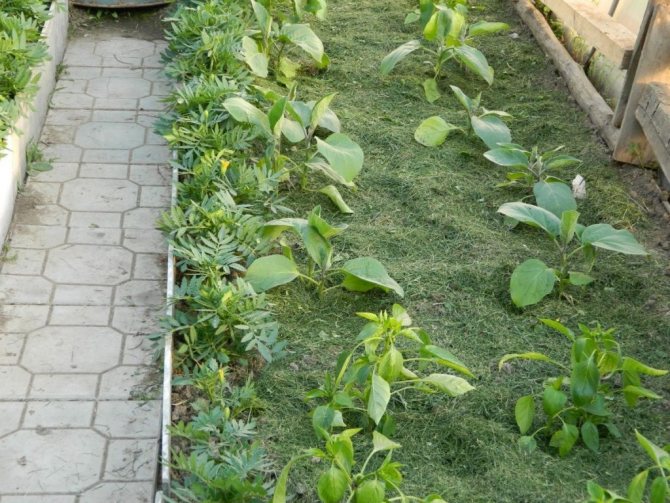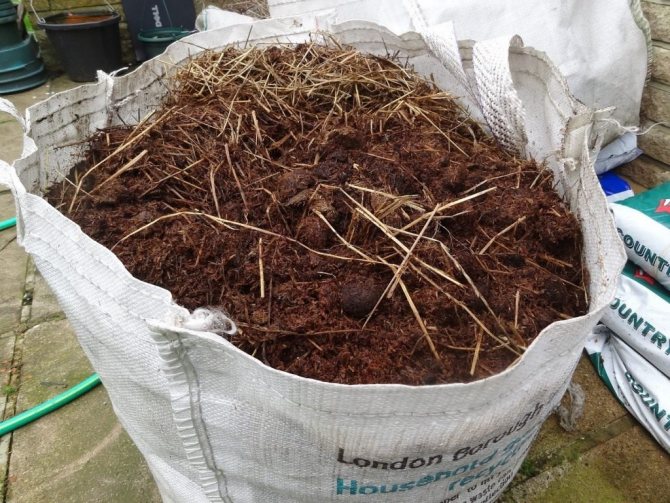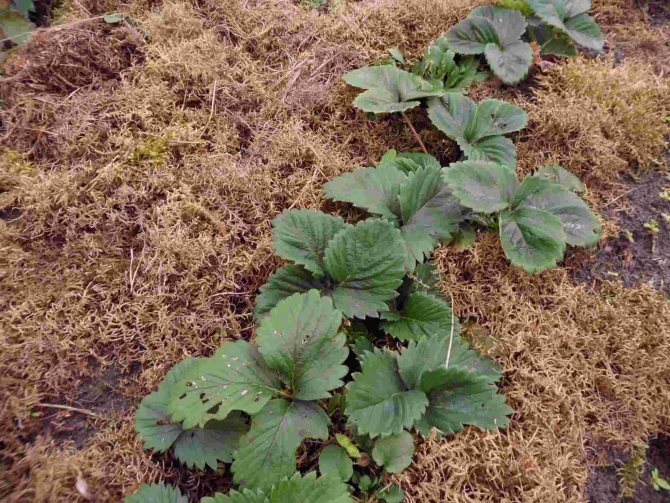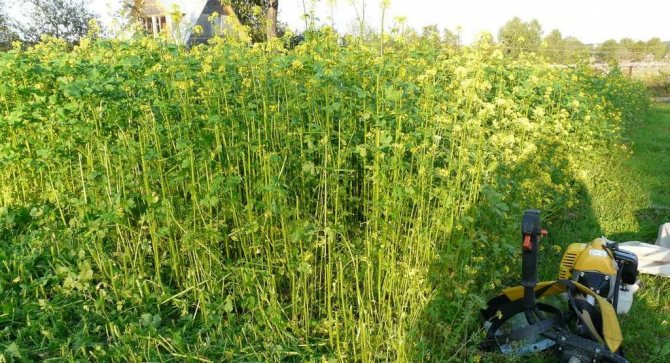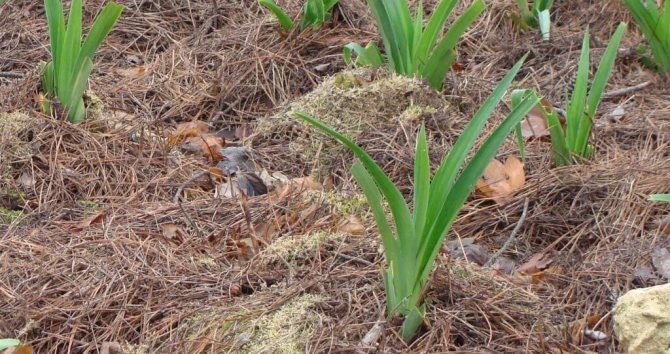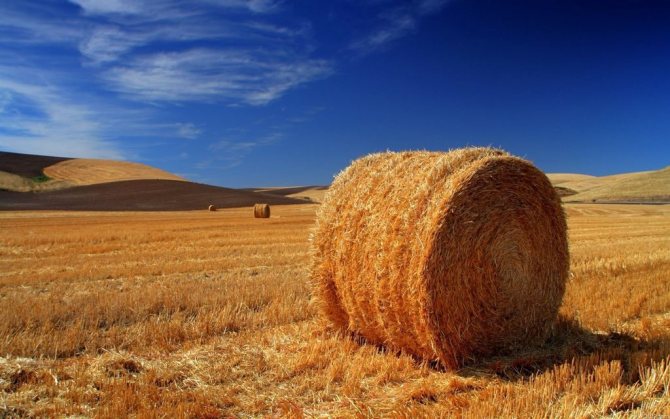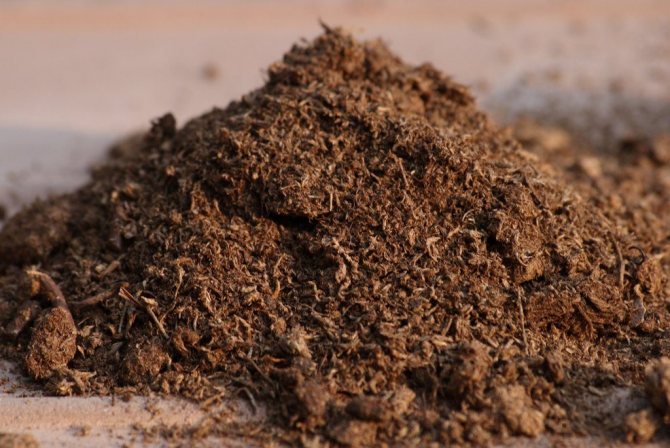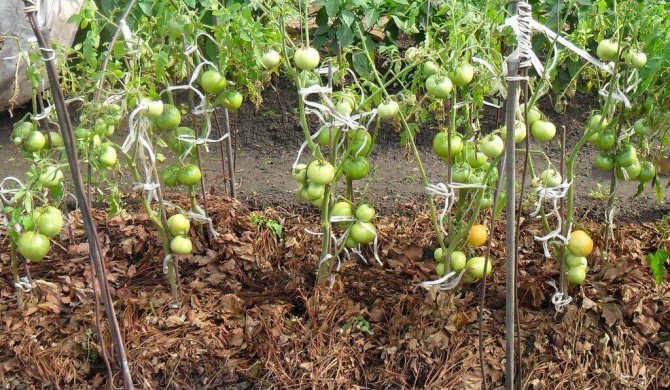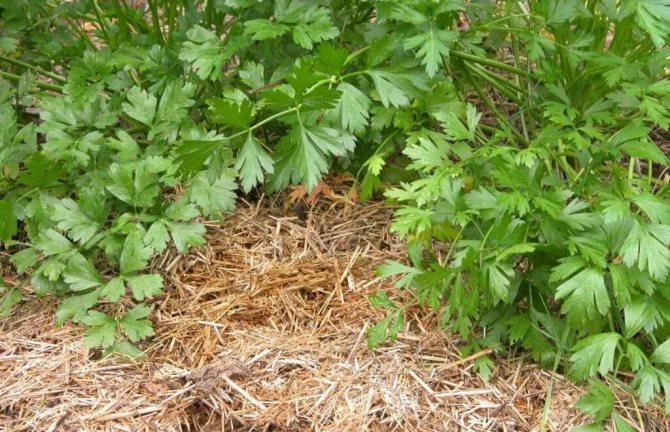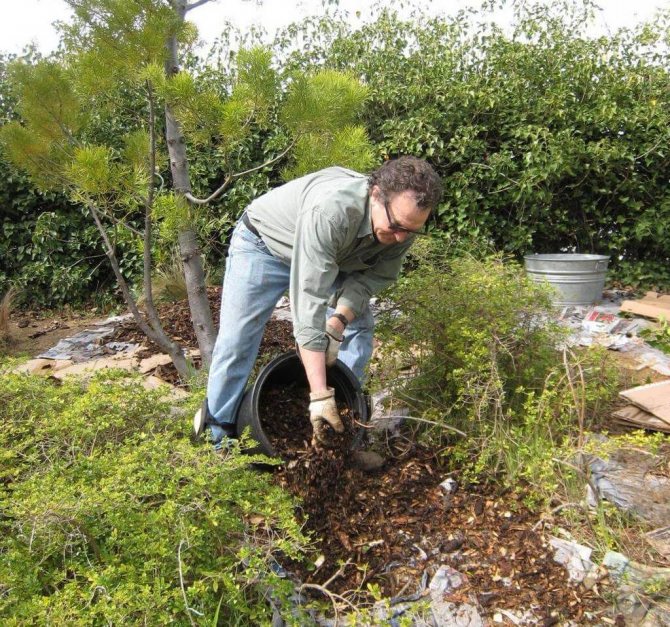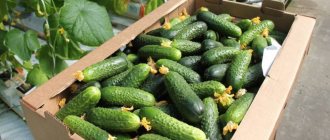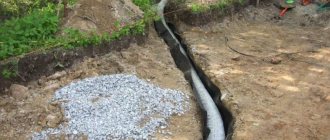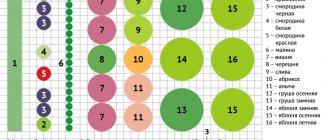Home »Garden and vegetable garden
Useful informationGarden and vegetable gardenTips for beginners
Olga Polyakova

Mulching is an important agricultural practice for almost all crops.
The essence of the technique is to create a near-surface layer that covers the space above the root system of the plant. In most cases, this layer is moisture saving.
Depending on the material used, it can be loose or hard. There are two main ways to create mulch: by constantly loosening the soil or by using special materials.
See also: What to plant under the trees: flowers, plants or vegetables? In the garden or garden in the shade (40+ Photos & Videos) + Reviews
DIY mulch
To protect crops from weeds, many gardeners use a simple trick. They spread a small protective layer of paper on the prepared beds (you can use newspapers, cardboard, bark or sawdust), water it with water, and then plant the plants.
The sun's rays do not penetrate the thick layer of mulch and weed shoots quickly die. In addition, mulch retains moisture for much longer, and also prevents water splashing and erosion of the topsoil. Try to make it simple mulch from newspapers
you will be overwhelmed by the effectiveness of this method!
You need
- newspapers or cardboard
- bucket
It is important to know: weeds (even plucked and treated with chemicals), as well as fallen leaves (they can be carriers of harmful microbes or fungi), cannot be used as mulch.
It happens that in a hot, dry summer, there is a catastrophic lack of water and gardeners are faced with an acute problem of how to preserve moisture in the soil. In this case, mulching the soil will help. How to make mulch with your own hands
we will consider in the article.
"Country hobbies"
Pros and cons
Many gardeners believe that paper mulch can lead to nitrogen starvation of cultivated plants. In a sense, they are right, but only if you cover the depleted soil. If the soil is fertile, then paper mulch is an excellent nitrogen regulator.


What are the positive aspects of mulching the soil with cardboard:
- Weed control in summer. In addition, all harmful plants can be removed under a layer of paper and cardboard in two years.
- Preservation of the root system in the winter. It is especially important to mulch the soil in regions with little snow, since the air temperature under the cardboard is 3 ° C higher than outside.
- Under cardboard mulch, plant roots do not overheat in hot weather.
- Having absorbed moisture, the cardboard gradually releases it, due to this, the moisture around the plants increases, and the temperature balance is maintained.
- Saves time and effort for the gardener.
If we talk about the minuses, then in winter, under a paper shelter, rodents and pests can wait out the harsh time.
What is mulch?
This is the covering of the plant-free surface of the earth with a loose layer of material of organic and inorganic origin. Mulch protects the soil from drying out by maintaining a constant temperature day and night, creating good living conditions for soil bacteria and worms.
What mulch gives
- There are no temperature fluctuations under the mulched material either day or night.
- The surface under the mulch remains moist even in extreme heat. In such a layer of soil at a constant temperature, worms, beneficial microorganisms, bacteria actively and fruitfully work, decomposing organic matter and emitting carbon dioxide.
- A favorable gas exchange takes place between the soil and the air, carbon dioxide is formed under the influence of moisture, which creates favorable conditions for the assimilation of earth minerals by plants: nitrogen, potassium, phosphorus and others. Worms, passing organic matter through digestion, produce humus, which serves as food for plants. Therefore, the more humus is produced, the more fertile the land. Hence an important conclusion, the more microflora in the soil, the richer it is in nutrients.
DIY mulch
mulching plantings
Types of mulching materials
Inorganic mulch
protects the garden from the growth of weeds and retains moisture well. It includes: roofing material, roofing felt, non-woven material, film, pebbles, crushed stone. It is used to decorate flower beds, garden paths, dry streams, rockeries. Mulching materials are often combined - first, they are covered with a film, and then crushed stone or pebbles are covered. Inorganic is used to destroy perennial weeds. For example, bindweed, sow thistle, wheatgrass. Covered with a black film during the season, they die without sunlight.
Organic mulch
in addition to those listed advantages, decomposing, serves as food for worms and soil microorganisms. It includes: fallen leaves, hay, needles, sawdust, peat, straw, tree bark, cut grass, wood chips, cake, paper, cardboard.
Do I need to mulch the soil in the greenhouse?
Young plants are most susceptible to external factors. Despite being in a greenhouse, they remain unprotected against temperature extremes, lack of moisture, and nutritional deficiencies. Mulching in greenhouses:
- minimizes thermal vibrations;
- protects seedlings from weeds and diseases;
- improves the growth of the root system, thereby reducing the percentage of plant death.
Organic materials are best suited for mulching in greenhouses. In terms of usefulness, in the first place are: humus, sawdust and straw. In second place is paper, cardboard and roofing felt. In the absence of the above materials, the use of film and spunbond is allowed.
How to make mulch with your own hands
Mulch their needles
It should be used for berry crops and flowers that love acidic soil. These are blueberries, cranberries, strawberries, heather, rhododendron, hydrangea, hosta, fern. The layer of needles, as well as pine bark, must be at least 3 cm.
Fallen leaves mulching
This mulch is used in flower beds, flower beds with perennial bulbous flowers, cucumber plantings. and placed on the future cucumber garden with a large layer of more than 40 cm. Snow compacts this layer and in the spring it has a thickness of no more than 3 cm. The foliage slowly melts until July, but perennials calmly make their way through it in due time.
A layer of fallen leaves should be shed with a solution of Fitosporin-M to destroy the spores of fungal diseases.
In the spring, on a cucumber bed in the foliage, make a hole, spill it with hot water (more than 40 degrees). By July, there will be no trace of the foliage - worms and microorganisms will process it, enriching the soil with humus.
You should not use the foliage of oak, walnut, poplar as they have a decent amount of growth hormones that slow down the development of plants.
Hay mulching
It is suitable for all summer cottage crops: vegetables, flowers, berry bushes and fruit trees. Hay will not only retain moisture, but increase the yield of the land. The layer of mulch with hay should be at least 5 cm.
mulch their hay
Weed and cut grass mulch
It is also suitable for all crops grown.Unlike hay, it immediately emits carbon dioxide. Put a layer of mulch 5-7 cm.
You should not use overgrown grass and weeds with seeds for mulch, so as not to clog the soil with their seeds. It is better to compost such grass.
Straw mulching
T. The straw is added gradually as the potatoes grow to a layer of 40 cm, leaving the tops in the air up to 5 cm. Planting in this way allows you to get a rich harvest of healthy, surprisingly clean tubers. In dry weather, it is important to ensure timely watering of the potatoes under the straw. In addition, straw can be used to mulch raspberries and other plantings in the country. The straw layer should be up to 10 cm.
Sawdust mulching
The use of sawdust as mulch is controversial. It must be remembered that fresh sawdust requires soil nitrogen for decomposition. Therefore, do not use fresh sawdust immediately. Since autumn, they are poured in a small layer of no more than three centimeters, or they are kept for a year in the open air. To avoid soil acidification, the beds are filled with wood ash. Sawdust mulching is suitable for strawberries, raspberries and other vegetable crops.
trunk mulching
Chip mulch
It is universal for almost all crops grown. Chips can be made by processing cut branches from fruit trees, berry and ornamental shrubs on a garden shredder. A layer of chips is poured at least 3-4 cm. The chips are not inferior to the bark, looks good on flower beds and beds.
Paper and cardboard mulch
For the development of a new bed (virgin land), it is advisable to use paper and cardboard.
They do it this way.
In the spring, they outline a future bed, trample weeds on it (food for worms). For poor soil, fresh manure or humus is scattered.
Now put on top 2-3 layers of newspapers or 2 layers of magazines without gloss. Next, put packing cardboard, bark or sawdust. All are well watered. Cardboard and paper will cut off the sun and suppress weed growth.
Pour about 10 cm of any organic matter (manure, compost) on the cardboard and then cover it with straw, foliage, grass with a layer of 5-6 cm. The nutrient layer stores moisture and provides nutrients, and mulch protects from the sun.
Now on this site you can plant potatoes, zucchini, pumpkin, tomatoes, peppers. For this, cardboard and paper are pierced and potatoes or seedlings are planted, covering the hole with earth, watered and covered with straw.
Watering such a flaky bed is rarely required, as the mulch retains moisture well.
You can mulch tomato plantings with newspapers, after soaking the newspapers. A trench is dug for planting tomatoes and wet newspapers are laid in it in 5 layers and sprinkled with a small layer of humus. When planting seedlings, a layer of newspapers is cut so that the roots of the tomato reach the soil. Newspapers or other mulch are again laid on top of the surface. In addition to tomatoes, you can also mulch cucumbers, potatoes, peppers, zucchini, pumpkins.
So, we figured out. The main thing is that mulching with organic matter helps to retain moisture in the ground, suppresses weeds and provides nutrition to the soil microflora, which leads to the enrichment of humus.
Share with your friends on social networks!
The site is non-commercial, it is developed on the personal funds of the author and your donations. You can help!
(Even a small amount, you can enter any amount) (by card, from a cell phone, Yandex money - select the one you need)
Thank you!
I invite you to the group for summer residents, gardeners: "Country hobbies"
Everything about country life: cottage, garden, vegetable garden, flowers, rest, fishing, hunting, tourism, nature
Good day, dear gardeners! On a personal plot, mulch is extremely necessary - made with your own hands or purchased already ready-made. Loose material is useful in the garden for many reasons.At the same time, organic mulch made by yourself is much more profitable than purchased from both a financial and environmental point of view.
What is mulch for, what materials can it be made of and what subtleties should be remembered when applying protective dressing in your garden? These are the main issues to consider.
Why is soil mulching necessary?
Regardless of the material from which the mulch is made, it performs a number of important functions in the garden:
- Mulch inhibits the growth of weeds.
- Reduces evaporation of water from the soil surface and protects the soil from erosion. This is especially important on sandy substrates and in dry climates.
- Maintains a relatively constant soil temperature and protects plant roots from overheating.
- Organic mulch creates good conditions for earthworms and other beneficial soil inhabitants.
- The protective dressing serves as a source of humus and thus improves the soil fertility in the garden.
- Additionally, mulch can serve as a decorative coating in harmony with.
The main mistakes when mulching
One of the most common mistakes when mulching is the wrong choice of the thickness of the material layer. Not thick enough leads to the fact that the benefits of agrotechnical reception are completely lost.
A thin layer is not able to retain soil moisture and does not protect the soil from overheating. It also does not prevent weeds from germinating. On the contrary, a layer that is too thick, especially if the material is heavy, leads to acidification of the substrate and poor air passage to the roots.
Despite the difficulties that a gardener may face when using mulch, you should not neglect this agrotechnical technique on your site. The correct selection of material and its competent use in the garden and vegetable garden is the key to good plant growth and a high yield.
Mulch material
Most often, do-it-yourself mulch is made from organic raw materials:
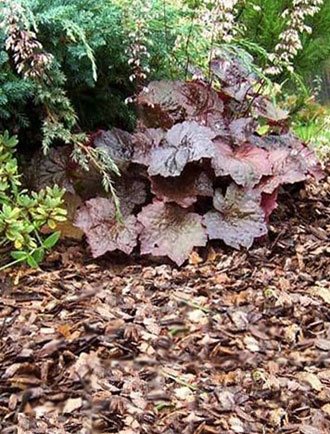

- bark and wood chips;
- shavings of different sizes;
- sawdust;
- leaves and humus from them;
- compost;
- spruce branches;
- coniferous litter;
- cones;
- husks of seeds and cereals;
- shells of nuts;
- straw;
- peat;
- weeded grass (without seeds);
- cut grass;
- cardboard and newspapers.
For mulching the soil, ready-made inorganic material is often used, which does not require additional processing:
- crushed stone;
- marble chips;
- pebbles;
- slate;
- polyethylene film;
- roofing material;
- non-woven fabric.
Frequent mistakes
Gardeners, who for the first time adopted the mulching of the soil with paper materials, often make mistakes.


Let's consider the main points to which you need to pay special attention:
- When mulching the soil with cardboard and newspapers, abundant watering should not be allowed. Excess moisture can cause putrefaction of the roots of planted plants.
- When stacking cardboard, you need to ensure that there is an air gap between it and the soil. That is why sand is poured over the cardboard, and heavy objects are placed only at the edges.
- It is not recommended to water planted plants after the soil has been mulched, because it was moistened before.
- The cardboard layer should not be too thick or thin. For example, cardboard boxes from under furniture are stacked in one layer, and less thin sheets can be duplicated.
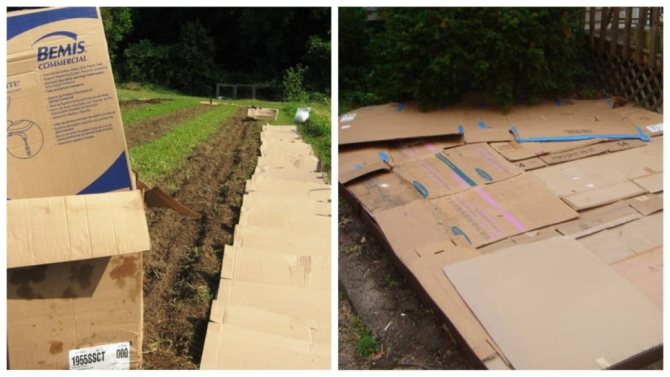

Only correct mulching with cardboard can improve the structure of the soil, destroy weeds and get a rich harvest of vegetables, berries and fruits. So that the paper does not spoil the appearance of the site, it can be "decorated" with mown grass.
How to prepare mulch with your own hands
When making sprinkles, it is necessary to take into account the characteristics of each material. For example, chips, wood shavings and sawdust
contain little nitrogenous substances, therefore, during decomposition, the material will extract nitrogen from the substrate. To prevent this from happening, nitrogenous fertilizers should be applied before mulching the soil.


If for mulch preparation is taken tree bark
, then the pieces should not exceed 5 cm. This variety is used for mulching the soil in a raspberry tree or in an orchard. Home-made mulching material from bark or spruce branches can be made using a garden shredder that comes with different knives.
The advantage of hand-made wood mulch also lies in the fact that it can be painted with the help of special environmentally friendly wood impregnations. The result is a bright, beautiful dressing that can be used to turn the garden into an unusual oasis.
Mowed or weeded grass
, as well as
moss
you must first dry it in the sun so that such mulch does not rot in the garden. This coating is suitable for the soil in vegetable beds.
Very much appreciated in horticulture nettle mulch
... First, the mowed aerial part of this plant is dried in the sun for two hours, and then crushed (with a knife or in a feed chopper). It is useful to use such a dressing on the beds of almost all garden crops: tomatoes, cabbage, cucumbers, peppers, strawberries. It is noticed that the next year after using the nettle, the plants do not get sick with late blight.
The cardboard is cut into strips or pieces of any shape. Paper mulch is moistened with water and placed on the ground tightly so that there are no gaps. Newspapers or paper can be laid out in whole sheets, it is only necessary to fix such mulch on the soil so that the wind does not carry it away.
Rules and process steps
Since paper mulch needs to be laid on nutrient-rich soil, it needs to be fed. When the ground warms up a little, the site is sown with green manure.
By the second half of May, the plants will rise by 10-15 cm. They are cut off, the green mass is scattered over the ridges, then the soil is dug up. Siderata and their roots over the summer will rot, turn into humus, enrich the soil with nutrients and microelements.
If gardeners do not sow green herbs to enrich the soil, then in the fall or at least early in the spring, before digging a site for 1 m 2, you can add a bucket of compost or humus. Wood ash does not hurt, since it contains a large amount of useful trace elements.
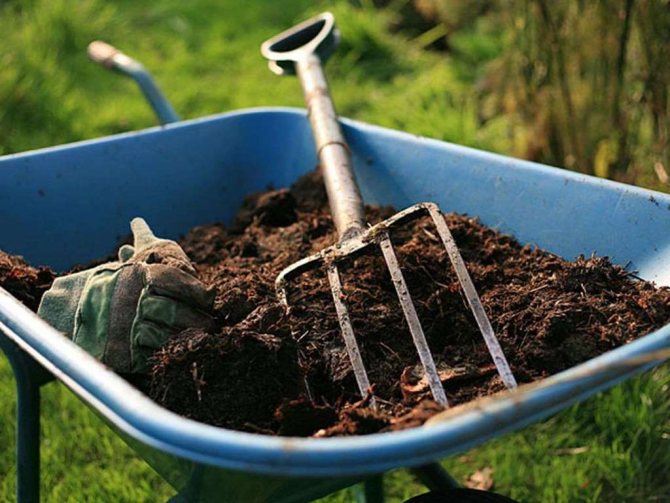

After planting crops, mulching is carried out with cardboard or newspaper sheets.
There is an algorithm for performing work:
- The site is watered abundantly with water.
- Open the cardboard boxes, carefully remove the glue, staples and tape with which they were fastened.
- Depending on the crops to be planted under the mulch, holes are cut in the cardboard plates. For potatoes, the holes are 16x16, for crops that are planted in grooves, the holes must be of the appropriate shape.
- The cardboard is laid on the ridges, the edges should overlap each other by at least 30 cm.Make sure that the ground is not visible between the cardboard mulch.
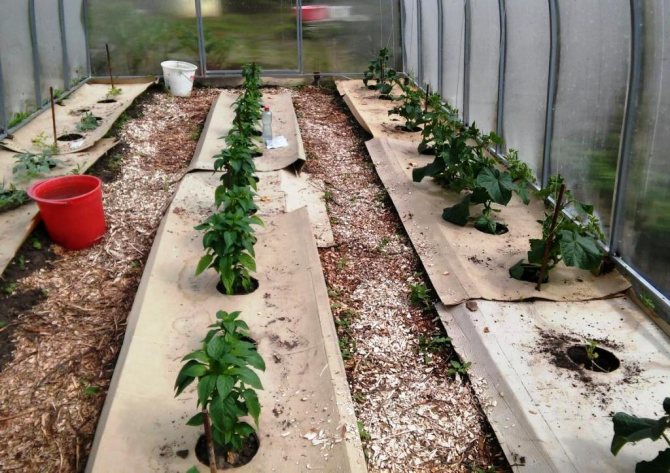

The edges of the paper are pressed with something heavy, such as bricks, planks, pipes, or large stones. If the cardboard is not pressed to the ground, it can fly away in a gust of wind or grow up weeds.
It is important to understand that the soil under the paper mulch must be moist, otherwise the desired effect will not be obtained.
Rules for mulching beds
Mulch should not be poured close to the trunks of woody plants and herbaceous stems. This is a preventive measure against decay.
If the mulch is used in damp places, there is a risk of attracting a large number of slugs and snails. These molluscs are very troublesome. For special measures should be taken. But in order not to create a breeding ground for slugs, it is necessary to water the plants at the root, then the mulch will remain dry.
Spring soil mulching is carried out in May - early June, when the soil has time to warm up, but will still retain a large amount of moisture. Before mulching the beds, perennial rhizome weeds must be thoroughly removed. To prevent them from reappearing, the mulch layer should be 5-10 cm.
And in addition, a useful video about soil mulching especially for you:
Rich harvests to you! Nadezhda Goryunova
Mulching is the covering of the soil surface with mulch in order to protect it from drying out and overheating, as well as to improve its properties. Mulching is considered as a way to improve the physical agronomic properties of the soil, as well as the effectiveness of the mineral nutrition of agricultural plants. Mulching is a promising way to preserve soil moisture and prevent soil loss due to erosive processes. Mulching is carried out both in greenhouses and outdoors.
Regardless of what the mulch is made of, it is capable of performing a number of important functions:
- thanks to the mulch the growth of weeds is suppressed
- less evaporation of moisture from the soil surface
- the soil is protected from erosion (this is especially valuable in areas with sandy soil and dry climatic conditions)
- maintains a stable soil temperature as a result of which the root system of plants is protected from overheating
- is an excellent decorative coating in the garden
- favors good conditions for the life and development of earthworms and other soil inhabitants
- is a source of humus, which increases soil fertility in the garden
- the soil under the mulch remains loose, as a result of which the plant roots are provided with an optimal air regime and after watering and rains there is no need to loosen the soil.
- mulch can inhibit the development of soil diseases, especially phytophthora. In addition, in the process of composting mulch in combination with the use of microbiological preparations, pathogens and fungi in the soil itself are suppressed, thanks to which it heals
Gardening tips
Gardeners need to understand that life is in full swing in the soil. Cardboard and newspapers are gradually being recycled by worms, mushrooms, microorganisms. This does not happen in one year. To speed up the process, the soil under the paper cover needs to be watered from time to time, especially in dry weather.
At first, the processed substances will be found only in the upper part of the soil; plants cannot yet use them. After all, their root system often takes nutrition from deep layers.
You can help plants in the assimilation of nutrients with the help of EM-bokashi, sprinkling it before laying the cardboard. EM bokashi are "efficient microorganisms" that are grown using wheat bran. Thanks to this fertilizer, soil fertility can be restored.


There is another way - watering the ridges with water to which microorganisms have been added, for example, the biological fertilizer "Baikal EM-1". It is thanks to the microorganisms found in the soil and those that have been added under the mulch that hard cellulose is processed faster.
Cardboard as mulch is better suited to newspaper and magazine pages, since there are practically no synthetic dyes on it.
Do not keep paper mulch for more than one year in a particular garden or greenhouse. It is advisable to change the cardboard every season.
Mulch types
The material for the preparation of mulch is organic and inorganic raw materials.
The most commonly used organic materials include:
- straw, hay - an affordable material, retains moisture well, reflects the sun's rays, quickly turns into humus
- wood shavings, sawdust - for effective control of germinating weeds, the layer must be made thicker, the material must be weathered before laying
- peat - retains moisture well and improves the structure of the soil
- leaves and humus from them
- needles, spruce branches, cones
- shells of nuts
- husk of seeds and cereals - retains moisture well
- weeded grass, mown green manure
- cardboard and newspapers - help to retain moisture and fight weeds.
When making such mulch, the characteristics of each material should be taken into account. For example, wood shavings, sawdust, chips contain little nitrogenous substances, as a result of which the material will draw nitrogen from the substrate during decomposition. Therefore, to prevent this process, nitrogenous fertilizers should be applied before mulching.
Among inorganic materials, it is worth noting:
- rubble
- marble chips
- roofing felt
- non-woven fabric
- plastic wrap (preferably black, although many gardeners grow tomatoes under red foil, cabbage under white)
- slate
- pebbles
- lutrazil
- expanded clay
Inorganic raw materials do not require any additional processing, they can be used immediately. But at the same time, it does not contain any useful substances and therefore is not capable of creating humus. In addition, it is not able to prevent overheating at elevated temperatures, and when using the film, its decomposition is possible with strong overheating. To prevent this, it is covered with straw or hay on top.
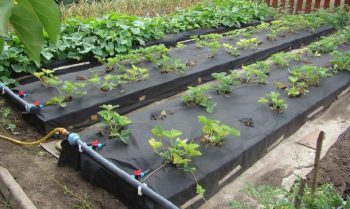

Features of soil mulching:
They begin to spread mulch in the spring, when the ground is already warm enough and has not yet lost moisture (if it is dry, it should be watered). All debris, dry branches, leaves are removed from the soil surface. The land is also cleared of weeds.
Depending on the selected material, the layer thickness changes during mulching. For bark or sawdust, the optimal thickness will be 5 cm, if it is a light layer (needles, leaves) - 7-8 cm.
Also, when applying mulch, the composition of the soil should be taken into account. For example, a thick layer of mulch is not recommended for loamy soils.
The mulching layer should not come into contact with tree trunks, plant stems. The mulching radius for shrubs is about 50 cm, for trees - 80 cm.
Vegetable beds and flower beds are completely covered, and vegetable seedlings are planted in the ground, which is previously covered with film or textiles.
The mulch remains usable throughout the entire season. In summer, when loosening the soil, the mulch is mixed with the ground, and in the fall, when digging, it is embedded in the ground. This applies to organic mulch.
Ideally suited for mulch application:
- spring - mulching of heated soil - this is the protection of plants from overheating and drying out;
- autumn - in the middle or towards the end of autumn, mulching of not yet supercooled soil is performed in order to prevent hypothermia and death of plants from hypothermia.
Before covering the soil, it should be enriched with fertilizers that will slowly decompose. The mulch layer is changed as the functions performed by it are exhausted (this depends on the materials that will be used).
The soil that has been covered with mulch must be watered more thoroughly so that the protective layer, which is wet, is on the moist soil.
Recently, the use of mulch has taken a strong position in landscape design: it is used for rock gardens and flower beds, when decorating garden areas in harmony with garden paths.
Making mulch with your own hands
The most accessible and simple is organic mulch: stems and leaves of plants, cut grass, cut weeds. They are crushed with scissors, a flat cutter, a lawn mower, a sickle, etc. In this case, it is recommended to dry freshly cut grass before use, otherwise there is a risk of various pests.
Sawdust should be mixed with resin and nitrogen before use. This mulch is recommended for horticultural and berry crops. Nitrogen treatment is best done with straw.
Seasoned gardeners prefer a combination mulch and often use two or three materials at the same time.
If the bark of trees is used, then the pieces should be no more than 5 cm. This mulch is used in a raspberry or in an orchard. This material can be made with your own hands using a shredder.
Today we will talk about different types of mulch. How to mulch with grass, straw, fallen leaves? How to cook your own mulch? What's the best for mulching strawberries?
Mulch in our understanding is, first of all, saving the soil from drying out. This is true, and three times true for the hot steppes. Earlier I wrote that it is impossible to live in the south without mulch, the soil dries up without it! In fact, it is impossible without it both in the rainy Non-Black Earth Region and in cold Siberia.
It is she who protects the soil from erosion by rainstorms. It is the organic matter of mulch that is the main source of carbon dioxide for photosynthesis and food for soil animals. It is mulch that protects the soil from temperature surges. During the day, it reflects the excess heat of the sun, and at night it stores the warmth of the root layer. It is only under the mulch that dew settles and goes to work, prolonging the effect of rain.
But first, I'll touch on the "non-organic" mulch.
We use mulch from black film only for strawberries - we put it once for three years, spreading organic matter under it. Without a good dose of organic matter, it makes no sense to lay a film: the soil will not improve.
Advantages of film mulch: moisture retains much longer, there are almost no weeds. Cons: it is not nutritious, not mobile, does not allow planting, compact planting. For densely sitting greens and root crops, it is not applicable at all.
In summer, the black film heats up. In the damp north, in Siberia, this is only beneficial. In our country, the film has to be covered with straw: in June it “heats up” to 70 ° C. And to be honest, I'm very reluctant to pull plastic out of the garden almost every year. But this is how anyone.
Of course, in Europe, and especially in Israel, mulch film is the basis of high-tech production. But the mulch films there are brought to mind: the right width, with holes, reflective and long-lived. And even with a yellow seamy side - it turns out that weed shoots die better this way. And now they are already biodegradable. Under them is a dose of organic matter and irrigation tapes, periodically supplying nutrient solutions with water. It's smart for the desert, and there is no other way out. For poor sandy loam and sand - also a radical way out, if you have money.
My main goal is the natural fertility of the soil. Therefore, my constant mulch - plant residues
: straw, grass from mowers, foliage and shredded branches. It is laid after the beds have warmed up, when the seedlings of tomato-cucumbers have taken root and arose, and juicy weeds torn out during planting, the remnants of greenery and radishes, fresh grass - a gift to worms just fall under it.
Here, for example, a young currant bush was cut to enhance growth. Under it lay 4–5 kg of fresh grass. Until August it will be eaten by worms. Imagine what kind of work they will do!
Straw
we take the baled one. It keeps weeds better than others. Bright, reflects light and does not heat up - this is an important plus for the south. Easy to lay in layers. It decomposes slowly over a year.
If you want to speed up the decay - sprinkle with a solution of sugar and urea, a glass on a bucket of water. It is the "fuel" for microbes that break down cellulose.
Traditionally strawberries are mulched with straw, in English - strawberry, "straw berry". All my beds usually go in the winter under mulch, covered with a thick blanket. Having removed the mulch in spring, I can sow and plant with my hands - the soil is perfectly prepared.
It is especially useful to cover the trampled autumn green manure with straw. By the spring, little is left of him. All the aisles and paths in the garden are covered without fail and constantly with straw - here the roots also feed and find moisture.
I can't help but mention: potatoes under the straw
... This method is successfully used by many.Warming up a little and loosening the garden with a pitchfork, sprinkle humus, compost, any nutritious organic matter on it. Put straw on top in a loose layer of 10-15 cm. With our hand we make passages in the straw and press the pieces of seed tubers with sprouts into the soil. We leave the holes so that the sprouts quickly get out.
We got out - we rake in the bushes so that the light does not pass to the soil. It's all. No need to spud, weed - almost the same. It is necessary to water well twice: at the time of budding and at the end of flowering. We harvest at the beginning of the yellowing of the tops. You don't have to dig: the tubers are right under the straw, clean.
Lawn Mower Hopper Grass
- perhaps the most ideal mulch for garden beds. It is nutritious, contains a lot of nitrogen and attracts crowds of worms. It cakes quickly in a dense layer and keeps weeds well. It's always damp underneath. Open from April until the end of the season. Replenished with mowing. Over the winter, it disintegrates completely. It's completely free.
Dry foliage
- the same as straw, but more nutritious, and packs more densely - a real blanket. Knowledgeable people store foliage in cubic meters. Anyone is suitable, except for oak and walnuts - it is better to lie on the sidelines for a year: they are too rich in aggressive tannins. The beds hibernate well under the foliage.
All this organic matter gradually decomposes, is eaten and dragged into the soil, where it feeds both microbes and plants, and in the end is humified.
Shredded branches
- super mulch. For several years I have been happily preparing it using an MTD rotary chopper, but I recognized and appreciated it only after I got acquainted with the developments of the Canadians.
It turns out that hardwood branches are thinner than 5 cm - just a warehouse of sugars, pectin, amino acids and vitamins. Wood fiber is a bonus and material for creating a particularly durable, high-quality humus. Indeed, forest soils are very fertile. Now it's clear why.
I mainly grind fruit branches, and not thicker than a finger. They are especially rich in sugars and proteins. The layer is also compacted, perfectly retains moisture and cuts off weeds. At the same time, the rug of small chips is very pleasing to the eye.
Leafy branches from summer pruning are especially good. A real food warehouse! Before chopping, the leaves must be dried, otherwise the chopper periodically slips, clogging up with a juicy mass. A pile of chopped branches with leaves begins to burn inside on the second or third day. The branches grow twice a year, and also completely free.
Which shredder is the best for twigs?
Better the one to which spare knives are sold! Take two spare kits at once. And advice: never grind dry tree branches. The machine is not designed for them! The knives will dull immediately. Dry branches - only for the fire. Exceptions are dry shoots of blackberries, maiden grapes and honeysuckle, thin willow branches, stems of weigela, buddlei, corn and other "hollow bodies".

